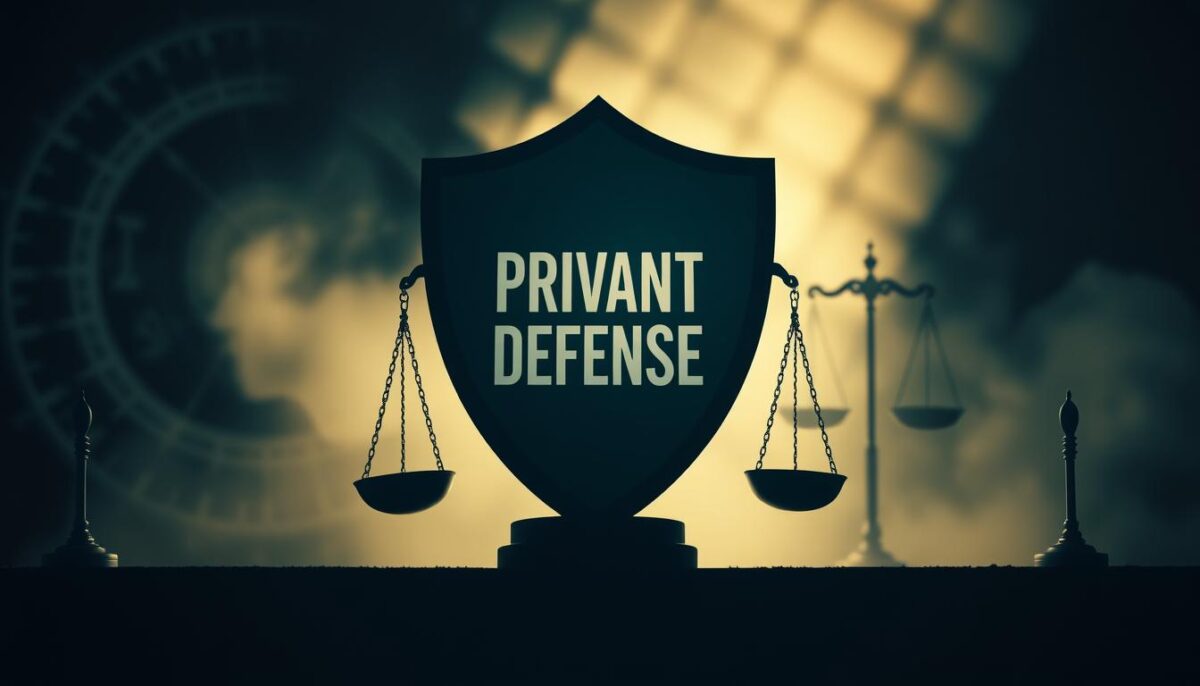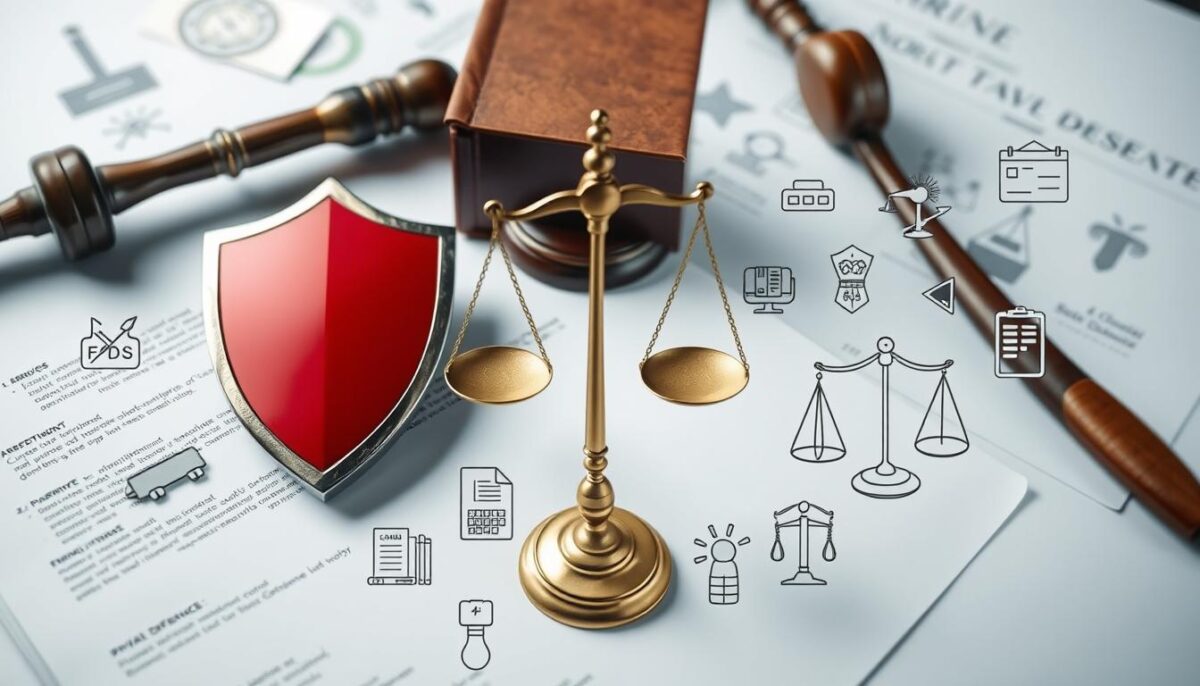Exploring the Bharatiya Nyaya Sanhita (BNS) shows how crucial the right of private defence in BNS is. This new law changes how India handles self-defense, giving people the power to defend themselves against harm. It started on July 1, 2024, and brings big changes to how we see protecting ourselves legally.
The BNS gives a detailed look at important legal rights. It covers many crimes, how to punish them, and when you can’t defend yourself. With 21 new crimes like hate crimes and mob lynching, knowing these changes is key. The BNS is more than a law; it’s a way to keep people safe in tough times.

Understanding the Bharatiya Nyaya Sanhita (BNS)
The Bharatiya Nyaya Sanhita is a big change in India’s legal system. It brings new legal reforms. This law replaces the old Indian Penal Code, making it simpler with 358 sections in 20 chapters.
It focuses on today’s society, adding laws for organized crime and terrorism. It also protects victims better.
One big change is making adultery and some sexual crimes not crimes anymore. This makes the law fairer for everyone. It uses words like ‘whoever’ to be more inclusive.
This shows India’s law is catching up with society. It also makes sure victims get the help they need.
The BNS also makes punishments harsher for serious crimes. It sets minimum punishments for big offenses. It also makes sure people who cause death through carelessness face tougher penalties.
Section 36 of the BNS helps people who don’t fully understand their actions. This could be because they’re young or have mental issues. It’s like the old law but updated for today.
The BNS makes legal processes easier, especially for cybercrime. It aims to make justice fair and quick for everyone. Knowing about the Bharatiya Nyaya Sanhita is important for understanding India’s criminal law today.
The Importance of Self-Defense Laws in India
It’s key to know about self-defense laws in India to keep safe. These laws give people the right to defend themselves against harm. The Bharatiya Nyaya Sanhita (BNS) updated these rights, making them clearer than before.
Sections 34 to 44 of Chapter III in the BNS talk about private defense. They set rules for when and how to legally defend oneself. The law says force must be reasonable and necessary, so personal safety doesn’t mean causing harm.
Self-defense laws are more than just rules. They help in real situations where danger is real. For example, Section 35 lets you defend yourself or others from harm. Section 40 says you can start defending yourself as soon as you see danger.
With crime rates going up, knowing these laws is more important than ever. The BNS sets limits on using force, making sure you act fairly and avoid too much harm. This way, you can protect yourself without breaking the law.
| Self-Defense Law Sections | Provisions |
|---|---|
| Section 34 | Clarifies that any act done in private defense is not an offense. |
| Section 35 | Right to defend oneself and others against bodily harm. |
| Section 40 | Right of private defense begins with anticipated danger. |
| Section 37(2) | Prohibits causing more harm than necessary. |
| Section 38 | Allows causing harm or death in self-defense under reasonable fear. |
Learning about self-defense laws helps me understand my rights and how to stay safe. This knowledge is essential for protecting myself every day.
Right of Private Defence in BNS
The right of private defense in BNS is key to protecting individuals and their property. It lets people defend themselves without fear of legal trouble. The BNS makes it clear that actions taken in self-defense are not crimes.
This gives people a clear understanding of how to protect themselves. It’s a guide for self-defense.
Legal Framework and Provisions
The BNS has important sections that support self-defense rights. Key sections include:
- Section 34: Says nothing is a crime when done in self-defense.
- Section 35: Allows defending oneself and others from harm.
- Section 36: States that self-defense is still valid against those with mental issues.
- Section 37: Says no defense against actions by public servants in good faith.
- Section 39: Limits self-defense to certain death situations.
- Section 40: Self-defense starts when there’s a real fear of harm.
- Section 44: Allows defense in cases where innocent people might get hurt.
Key Changes from the Indian Penal Code
The BNS changes from the IPC show big legal reforms in self-defense. The BNS is more open about when self-defense is allowed. This shows a better understanding of justice today.
For example, it now includes defending against those with mental issues. This makes people feel safer and ensures justice is fair.
Justifiable Use of Force Under BNS Law
The Bharatiya Nyaya Sanhita (BNS) sets clear rules for using force in self-defense. Knowing these rules helps me act responsibly when faced with threats. It lets me use force wisely, following the law’s self-defense standards.
Defining Justifiable Force
Justifiable force is the amount of force I can use to defend myself. The law says this force must be reasonable and match the threat. It’s important to use only what’s needed to avoid harm.
This idea stops the misuse of self-defense rights. It also shows the conditions for lawful protection in different situations. BNS Section 37 aims to prevent abuse and promote responsible defense.
Limitations and Conditions
Even though the BNS gives power to individuals, there are limits to self-defense. I can’t use self-defense if I provoke someone or if I can get help from the authorities. Also, using force against public officials who are doing their job is not allowed.
These rules are key to using defensive action legally. Knowing them helps me act smartly and legally when danger comes.
Legal Boundaries of Self-Defense
The Bharatiya Nyaya Sanhita (BNS) sets clear legal limits for self-defense. These limits are key to making sure my actions are legal. They define when self-defense is okay, mainly when there’s a real fear of harm or death.
Knowing the rules of lawful self-defense helps me understand when to protect myself and others. The law says my actions must match the threat. For example, if someone is seriously threatening me, I can only use enough force to stop them without going too far.
The BNS also follows past legal cases like Darshan Singh vs. State of Punjab (2010). This case lists ten situations where self-defense is okay. Jassa Singh vs. State of Haryana (2002) also shows that defending property doesn’t mean causing death just because someone trespassed. This rule helps prevent misuse of self-defense.
There are also rules on what actions are okay in self-defense. Section 99 of the BNS says I shouldn’t cause more harm than needed. I must prove my actions were justified, showing I had a real fear of danger.
It’s important to understand these laws well. Not every self-defense action is legal. The rules are there to stop people from using self-defense for aggressive reasons.
For more information on the BNS and self-defense, check out this article online.
| Case | Legal Principle | Significance |
|---|---|---|
| Darshan Singh vs. State of Punjab | Establishes ten situations for self-defense | Clarifies when self-defense applies |
| Jassa Singh vs. State of Haryana | Limits self-defense for property | Prohibits lethal force in non-lethal threats |
| Chotelal vs State | Affirms right to defend property | Sets precedent for property defense rights |
| Parichhat vs State of M.P. | Family defense rights | Encourages protection among family members |
Defence Against Unlawful Aggression
The idea of unlawful aggression is key in self-defense laws under the Bharatiya Nyaya Sanhita (BNS). It lets me defend myself when my safety is at risk. When I’m in a tough spot, knowing this helps a lot.
Unlawful aggression means there’s an immediate danger that justifies defending myself. I can use private defense if the police can’t help right away. This way, I stay safe while following the law.
The BNS has rules about how much force I can use in self-defense. These rules help prove if my actions were justified. For example, if I see a real threat, I can defend myself or others. But, my response must be only what’s needed.

Lawful Self-Protection: What It Means
Knowing about lawful self-protection is key to keeping safe. It’s based on the Bharatiya Nyaya Sanhita (BNS), which says we can defend ourselves when threatened. It’s about finding a balance between staying safe and following the law.
Section 34 of the BNS says defending yourself is not a crime. This means you have the right to stop threats. For instance, if someone tries to break into your home with bad intentions, you can use force to stop them.
Section 35 also protects you and others from harm. It says you can defend anyone from danger, even if it’s not life-threatening. But remember, you should only use as much force as needed, as Section 37(2) states.
The BNS also explains when you can use self-defense. Section 38 says you can defend yourself if you’re in serious danger. This means you can take stronger actions if you’re facing a real threat. Section 40 says you can keep defending until the danger is gone.
Self-defense is about stopping harm, not punishing. The law says it’s up to the State to handle offenders. But if you defend yourself reasonably, you won’t face punishment, thanks to Section 34 of the BNS.
This knowledge helps me handle conflicts safely and confidently. The BNS gives clear rules for acting wisely in tough situations. Knowing my rights helps me prepare for any danger that might come my way.
Private Defence Provisions: A Comprehensive Overview
It’s key to know the private defence laws in the BNS. Sections 96 to 106 explain how people can protect themselves and their stuff. These laws make it clearer how to defend oneself in everyday life.
Sections 96 to 106 of the BNS
Sections 96 to 106 of the BNS give a comprehensive legal overview of private defence. The main points I find important are:
- Section 96: Says actions taken in self-defense are not crimes.
- Section 97: Allows defending one’s body and property against certain crimes.
- Section 98: Tells when self-defense is okay, even if the other person isn’t committing a crime.
- Section 99: Limits self-defense to only using reasonable force.
- Section 106: Gives the right to defend oneself if there’s a real fear of harm.
Relevance to Everyday Situations
These BNS sections are important for everyday self-defense. They give people the power to act when police can’t help right away. Whether it’s stopping a personal attack or protecting property from theft, these laws are crucial.

Knowing the private defence laws in the BNS helps me deal with different situations. It shows how important it is to understand these laws for personal safety. It also teaches us to act reasonably when faced with danger.
Self-Defence Justification in Criminal Cases
Understanding self-defence in criminal cases is key. It helps us deal with the legal system, especially under the Bharatiya Nyaya Sanhita. Self-defence claims can change case outcomes. It’s important to show that the force used was justified and matched the threat.
The BNS and Indian Penal Code say we have the right to defend ourselves and others. This right is in various sections. It lets us protect ourselves or others when there’s an immediate threat. It’s important to explain these justifications well, as they can influence court decisions.
Self-defence has its limits. Sections 96 to 106 of the IPC explain when it’s okay to defend oneself. For example, Section 97 lets us defend against theft and trespass.
To justify self-defence, we must show we were really scared. We need to explain why we couldn’t get help from the police. But, using too much force is not allowed.
| Section | Right Established | Conditions |
|---|---|---|
| Section 96 | No offence for acting in self-defence | Right of private defence defined |
| Section 97 | Defend body and property | Against offenses affecting human body and property |
| Section 99 | Restrictions on self-defence | No right against public servants acting in good faith |
| Section 100 | Use of force resulting in death | Only when there is an imminent threat to life |
| Section 106 | Defend against deadly assault | Even when it risks harming an innocent person |
Knowing about self-defence in criminal cases helps us face legal challenges. It’s important for understanding the impact of self-defence claims in court.
Reasonable Force in Self-Defense: An Analysis
Understanding reasonable force is key in self-defense claims. The Bharatiya Nyaya Sanhita (BNS) says defensive actions must match the threat. This legal look at both the IPC and BNS shows how force applies in different situations.
The C. Ganesh Narayan v. State of Karnataka case shows how important this rule is. The court said pepper spray is okay only when there’s a real threat to life. This shows that using force must be based on real danger.
The Indian Penal Code (IPC) sets clear limits on self-defense. For example, Section 100 allows deadly force in certain dangers. Sticking to these rules helps avoid legal trouble.
- The right of private defense allows the use of reasonable force.
- Proportionality is key; too much force can lead to legal trouble.
- There must be an immediate danger for self-defense to be valid.
Looking at the BNS sections, it’s clear that knowing about reasonable force is crucial. It helps me make smart choices in tough times and protects me legally after an event. Using force right starts with understanding the threat and legal rules.
Understanding Legitimate Defensive Action
In the Bharatiya Nyaya Sanhita (BNS), legitimate defensive action means doing legal acts when faced with an immediate threat. This idea is key to understanding rights in confrontations. It helps me know when to use lawful protection without crossing legal lines.
The BNS, especially Sections 96 to 106 of the Indian Penal Code, gives me the right to defend myself, my family, and property against illegal attacks. I can protect my body and belongings when police can’t help right away. The force I use must match the threat, showing the importance of proportion in defense.
Knowing about private defense rights shows me the importance of not using too much force or starting fights. Section 97 says my actions are only okay when I’m in real danger. So, I must be careful with my defense, only reacting to threats, following the BNS’s rules.
